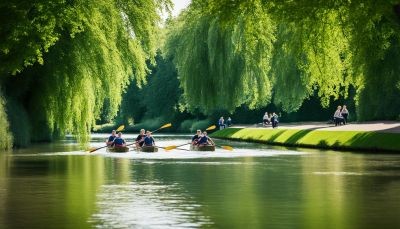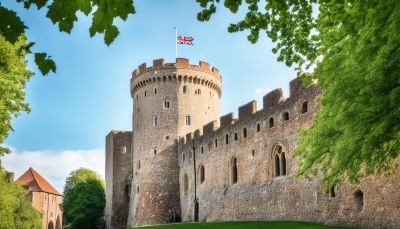Picture yourself walking the stunning Amalfi Coast in Italy. Imagine seeing its rocky shore, tall cliffs, and soft sand beaches that pull in visitors worldwide. But picking the best time to go can be tricky. The key is knowing about the area's weather and seasons.
This coast is known for its beautiful, colorful towns like Positano, Praino, and Amalfi. They have quaint museums, cozy hotels by the sea, and lovely walks along the beach. The weather makes the area even more inviting, especially from May to October. During this time, you can expect lots of sunshine and an extended summer. Yet, in fall and winter, it becomes windy, cold, and wet. The beach towns also get quieter then.
So, when's the best time to visit the Amalfi Coast for good weather? The answer depends on what you like and what you want to do. We'll explore when to visit based on weather and activities you enjoy. Let's discover the secrets of the Amalfi Coast's weather.
Key Takeaways
- The Amalfi Coast offers a range of weather conditions throughout the year, with the spring and fall shoulder seasons being the best times to visit.
- Summer brings hot, sunny weather but also high prices and large crowds, while winters can be cold, rainy, and windy with reduced services.
- Understanding the seasonal weather patterns and event calendars can help you plan the perfect Amalfi Coast vacation tailored to your preferences and budget.
- Beach lovers will find the warmest water temperatures and sunniest days in the summer months, while sightseers and outdoor enthusiasts may prefer the milder weather of the shoulder seasons.
- The Amalfi Coast is home to a variety of seasonal festivals and events that can enhance your travel experience.
Introduction to the Amalfi Coast
The
Amalfi Coast is loved by those seeking the sun, history, or natural beauty. It is a stunning part of Italy's shoreline. It's on the southern side of the
Sorrentine Peninsula. This area is well-known for its beautiful towns, each with its special charm.
Picturesque Towns Along the Coastline
Places like
Positano,
Praiano, and
Amalfi are on the
Amalfi Coast. They stand out with their colorful houses, small museums, and cozy seaside spots. To really know the area, walking through these towns is a must. You can enjoy the views, the food, and its history this way.
Allure of the Mediterranean Climate
The
Mediterranean climate is a big reason people come here. It means long,
sunny days and a drawn-out summer. This perfect weather lets everyone fully appreciate the coast. The beauty of the blue sea and green landscapes is at its best. Whether relaxing on beaches or hiking, the
Amalfi Coast mixes nature and culture well.
Spring: A Mild and Blossoming Season
Spring on the
Amalfi Coast is perfect for those who enjoy sunny, cool days. It's the season when flowers start to bloom. The area isn't as crowded as in summer. This makes it a great time to visit the
Amalfi Coast.
Average Temperatures and Rainfall in Spring
March brings
temperatures near 60 degrees Fahrenheit to the
Amalfi Coast. By May, the weather warms to around 72 degrees Fahrenheit. Rain is not common, but short showers might happen.
Spring offers a great mix of mild weather and few rainy days.
Packing Tips for Spring
For a spring trip to the
Amalfi Coast, pack light clothes. Be prepared: Bring a mix of long and short-sleeved shirts, T-shirts, and shorts. Don't forget a swimsuit and a sun hat for when it gets warmer. Plus, a light jacket, a scarf, and a small umbrella can come in handy for cooler evenings or surprise rains.
Summer: Peak Tourist Season
The
Amalfi Coast lights up in summer. The weather is lovely with
temperatures in the 80s F. Long days full of sun give way to cool nights from sea breezes.
In June, the ocean is around 75 degrees F. But by July and August, it warms to about 80 degrees F. This makes it great for swimming, snorkeling, and other water activities.
Hot and Sunny Weather in July-August
July and August see many visitors on the
Amalfi Coast. They come for its beautiful sandy beaches and clear waters. It's the busiest time, with the area's beauty and culture shining bright.
Crowds and Higher Prices
But, the summer popularity has downsides. The many tourists and vehicles cause traffic on the coast's narrow roads. Also, hotels are at their most expensive during this time.
For those who dislike
crowds and want to save, try visiting in spring or
fall. The weather is still nice, and the vibe is more peaceful.
Fall: Shoulder Season Delight
If you visit the
Amalfi Coast in the
fall, each month brings a different experience. In early
September, it's still very warm. But by mid-month,
temperatures drop to the 70s. This month is perfect: the
weather is warm enough, the seas are great for swimming, and it's less crowded. Plus,
accommodation prices are lower than in
July and August.
Cooling Temperatures and Fewer Crowds
In
October, it's cool with some warm,
sunny days.
November is even colder and the
rainiest month. Yet, the
fall shoulder season brings interesting
festivals and events. It's a time for a more peaceful visit with
fewer crowds.
Festivals and Events in Fall
Notable
festivals and events in
fall include the
Festa del Pesce in
Positano,
Sagra della Castagne in
Scala, and
Festa di Sant'Andrea in
Amalfi. These
events show the cultural richness of the
Amalfi Coast. They let visitors join in with unique traditions and tastes.
Winter: A Quieter Amalfi Coast
The Amalfi Coast is perfect in
winter for those who love peace and quiet. It starts in October when many places close. They open back up in April. During this time, the weather is cool and it might rain. But, it's great for long walks, reading, and visiting small churches and museums.
Average Temperatures and Rainfall in Winter
Winter in the Amalfi Coast means fewer people but a special feeling. The
temperature stays in the 50s, dropping to the 30s and 40s at night. Rain is more common, especially in November. But, it all adds to the unique charm of this beautiful place.
Reduced Services and Holiday Festivities
Winter here is very quiet because many places shut down. But, during the holidays, there are special
events. Christmas Eve, New Year's Eve, and Epiphany celebrations bring the coast to life. They offer a fun break from the quiet days and show off local traditions.
Amalfi, Italy: Best Months for a Weather-Savvy Trip
The
Amalfi Coast has varying weather all year. Some months are better for a
weather-savvy trip. The
shoulder seasons are
April-May and
September-October. These times have great weather, fewer people, and lower
prices.
Summer sees the most tourists. It's hot and sunny but also crowded and expensive.
Winters are cold and rainy, with closures. Knowing the seasons can help you enjoy the
Amalfi Coast more.
| Season | Ideal Months | Weather Conditions | Crowd Levels | Accommodation Prices |
|---|
| Spring | April-May | Mild, with occasional showers | Moderate | Lower |
| Summer | July-August | Hot, sunny, and dry | High | Higher |
| Fall | September-October | Cooling temperatures, some rain | Moderate | Lower |
| Winter | November-March | Cold, rainy, and windy | Low | Lower |
Ideal Times to Visit for Beach Lovers
For those who love the beach, visiting the
Amalfi Coast in July and August is perfect. These months are very warm and sunny. You can expect temperatures over 86 degrees F, making it great for a swim.
The sea is also warm, around 80 degrees F, perfect for various water sports and fun in the sun.
Warmest Water Temperatures
The summer on the Amalfi Coast means the water is at its warmest. This is great for beach lovers wanting to swim or snorkel. The sea usually stays about 80 degrees F, inviting you in for a good time.
Sunny Days for Beach Activities
July and August shine the brightest on the
Amalfi Coast. Days are long and perfect for beach activities. Whether you want to lie on the sand or try a new water sport, this is the time to go.
But, keep in mind, these months are popular. This means more people and higher
prices. Be ready for the
crowds on your trip to the Amalfi Coast.
Ideal Times for Sightseeing and Outdoor Activities
People who love
sightseeing and outdoor fun should visit the Amalfi Coast in spring or fall. The weather is nice for checking out the area's pretty towns and nature. Spring brings mid-60s to mid-70s temperatures, low rain, and fewer tourists than summer.
Pleasant Weather for Exploring Towns
September and early October in the fall are also great times to visit.
Temperature range from the 70s to 80s and you can enjoy local festivities. During these times, you can leisurely walk through charming towns, enjoy the pretty architecture, and try local food at outdoor cafes.
Hiking Trails and Scenic Walks
The cool spring and fall weather is perfect for exploring Amalfi's
hiking trails. The Sentiero degli Dei (Path of the Gods) from Praiano to Positano is a must. Hiking offers stunning sea views and lets you soak in Amalfi's natural beauty.
Seasonal Festivals and Events
The Amalfi Coast has many seasonal events for people visiting throughout the year. Spring offers religious processions and classical music. Fall and winter bring food
festivals and holiday celebrations. This makes the region lively and fun year-round.
Spring Festivals and Celebrations
The coast comes alive in the spring with Easter processions and classical music. The Ravello Concert Society hosts these concerts. The Ravello Festival features a mix of cultural events.
Summer Festivals and Celebrations
Summer brings many
festivals. Some include the Festa di Sant'Andrea in Amalfi and the Luminaria di San Domenico in Praiano. There's also the food festival Giornate del Pesce Azzurro in Cetara, showing off its seafood.
Fall Festivals and Celebrations
Fall is a time for celebrating with the Festa del Pesce in Positano and the Sagra della Castagne in Scala. Amalfi hosts the Festa di Sant'Andrea as well. These festivals are highlights of the season.
Winter Festivals and Celebrations
Winter holidays bring festive displays and fireworks. Visitors enjoy traditional Italian celebrations here. The season offers a magical time in this beautiful area.
Crowd Considerations
The
Amalfi Coastis very busy in the summer. Many people visit in July and August. They come for the beautiful towns, beaches, and great food.
The roads along the
Amalfi Coastcan get really crowded. This can slow down your journey a lot in summer.
Peak Summer Crowds
In summer, the
Amalfi Coastdraws many tourists. It's known for its beauty and
Mediterranean vibe. But, it gets so crowded that moving around can be a challenge.
It may be tough to explore the small towns or drive the
coastal roads in summer.
Quieter Shoulder Seasons
Spring and fall are much calmer on the
Amalfi Coast. There are less people and things move at a slower pace. This can be a perfect time for a visit if you want to avoid the crowds.
Consider visiting in
April-May or September-OctoberBy knowing when crowds are high or low, you can plan your trip well. This way, you can enjoy the
Amalfi Coast more.
Cost-Saving Tips
The Amalfi Coast is known as a pricey place for a holiday. Yet, there are smart ways to spend less. Traveling in the
shoulder seasons or
winter months means big savings. This is a chance to enjoy the Coast's beauty without a high cost.
Affordable Shoulder Season Rates
From
April-May and
September-October, the Amalfi Coast is more affordable. This is the
spring and
fall shoulder seasons. Hotel prices drop, making it perfect for budget travelers.
When you visit then, you won't pay as much. You can check out charming towns, go hiking, and eat great local food. It's a win-win without the summer throngs or costs.
Budget-Friendly Winter Travel
Traveling in the low-season, like
winter, can save you a lot.
Winter weather on the Coast can be cool and damp. But, the upside is, hotels and stores lower their prices.
This means you can see the region's calm, not crowded by many tourists. It's a different, more peaceful perspective, and you save while you savor.
Conclusion
The
Amalfi Coast of
Italy is famous for its beautiful
coastal views and lovely towns. Figuring out the perfect time to go is key for a great trip. The spring and fall months, like
April-May and
September-October, have great weather. Plus, you'll find fewer people and better prices on places to stay.
Summer is hot and sunny, making it ideal for those who love the beach. But, it's the busiest time and everything costs more. Winter is a bit cold and rainy, yet it's the quietest time to enjoy the
Amalfi Coast. Knowing this helps you plan a trip that fits your wants and wallet.
Choosing the right time to visit depends on what you love most about traveling. No matter if you're after sunny beaches, exploring quaint towns, or quiet seasons, the
Amalfi Coast has it all year round.
FAQ
What are the best months to visit the Amalfi Coast in Italy?
The best times to visit the Amalfi Coast are in spring and fall. Think April-May and September-October. You'll get nice weather, fewer people, and lower prices.
What is the weather like on the Amalfi Coast during the different seasons?
Spring (April-May) is mild, around the 60s-70s F, with little rain. Summers can be hot and sunny, in the 80s F. Fall (September-October) sees temperatures in the 70s-80s F. Winter gets chilly, with possible rain and wind, in the 50s.
What are the main attractions and activities on the Amalfi Coast?
The Amalfi Coast charms visitors with its colorful towns by the sea. Places like Positano, Praiano, and Amalfi are must-sees. You can enjoy swimming, snorkeling, and hiking in places like the Sentiero degli Dei. This path is known as the "Path of the Gods."
When is the peak tourist season on the Amalfi Coast?
The Amalfi Coast gets most crowded in July and August. These are the peak summer months. Expect lots of visitors, busy beaches and roads, and high prices for places to stay.
What types of festivals and events take place on the Amalfi Coast?
Throughout the year, the Amalfi Coast holds many special events. These include the Festa di Sant'Andrea in Amalfi and the Luminaria di San Domenico in Praiano. Also, there's the Festa del Pesce in Positano. Don't miss the winter holidays, like Christmas and New Year's, with their own celebrations.
How can travelers save money on a trip to the Amalfi Coast?
Traveling in spring or fall can save you a lot of money. The hotels are cheaper then. You can also find affordable places to stay in the winter. Just remember, not everything might be open during winter.





















